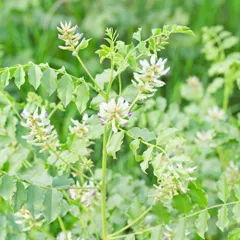Gan Cao Gan Jiang Tang
Chinese: 甘草干姜汤
Pinyin: Gān Cǎo Gān Jiāng Tāng
Other names: Licorice and Ginger Decoction


Gan Cao Gan Jiang Tang
Chinese: 甘草干姜汤
Pinyin: Gān Cǎo Gān Jiāng Tāng
Other names: Licorice and Ginger Decoction
Ingredients: 2 herbs
Category: Formulas that warm Interior Cold
- Warms the Lungs
- Strengthens the Stomach
Source: Essentials from the Golden Cabinet (220 AD)
The information provided here is not a replacement for a doctor. You shouldn't use it for the purpose of self-diagnosing or self-medicating but rather so you can have a more informed discussion with a professional TCM practitioner.
Gan Cao Gan Jiang Tang is a 2-ingredient Chinese Medicine formula with Dried Ginger (Gan Jiang) as a principal ingredient.
Invented in 220 AD, it belongs to the category of formulas that warm Interior Cold. Its main actions are: 1) warms the Lungs and 2) strengthens the Stomach.
In Chinese Medicine health conditions are thought to arise due to "disharmonies" in the body as a system. These disharmonies are called "patterns" and the very purpose of herbal formulas is to fight them in order to restore the body's harmony.
In this case Gan Cao Gan Jiang Tang is used by TCM practitioners to fight patterns like Lung Yang Deficiency. From a Western Medicine standpoint, such patterns can give rise to a range of conditions such as enuresis, excessive drooling or allergic rhinitis for instance.
On this page, after a detailed description of each of the two ingredients in Gan Cao Gan Jiang Tang, we review the patterns and conditions that Gan Cao Gan Jiang Tang helps treat.
The two ingredients in Gan Cao Gan Jiang Tang

Gan Jiang is a king ingredient in Gan Cao Gan Jiang Tang. Like the name indicates, it means it has more power than other ingredients in the formula.
1. Dried Ginger (Gan Jiang)
Gan Jiang warms the Lungs and disperses Cold. Its primary function is to restore the Yang in chest. However, its acrid and hot nature can hurt the Lungs by depleting the source Qi. To overcome this problem, blast fried Ginger is recommended as its acrid and dispersing effect is reduced.

Gan Cao is a deputy ingredient in Gan Cao Gan Jiang Tang. This means it helps the king ingredient(s) treat the main pattern or it serves to treat a coexisting pattern.
2. Liquorice (Gan Cao)
Part used: Dried root and rhizome
Nature: Neutral
Taste(s): Sweet
Meridian affinity: HeartLungSpleenStomach
Category: Tonic herbs for Qi Deficiency
Gan Cao tonifies the Qi. Together with Dried ginger, they warm and strengthen the Stomach, which in turn assist in resolving the Lungs disharmony. According to the the five phases theory, nurturing the earth (Stomach) can generate the metal (Lungs). The combination of sweet and acrid herbs warms the Yang and augments the Qi in a balanced manner.
Gan Cao Gan Jiang Tang is used to treat Lung Yang Deficiency
It's important to remember that herbal formulas are meant to treat patterns, not "diseases" as understood in Western Medicine. According to Chinese Medicine patterns, which are disruptions to the body as a system, are the underlying root cause for diseases and conditions.
As such Gan Cao Gan Jiang Tang is mostly used to treat the pattern "Lung Yang Deficiency" which we describe below.
But before we delve into Lung Yang Deficiency here is an overview of the Western conditions it is commonly associated with:
Enuresis Excessive drooling Allergic rhinitis Hayfever Epistaxis Abnormal uterine bleeding Peptic ulcers Chronic gastritis Emphysema
Again it wouldn't be correct to say "Gan Cao Gan Jiang Tang treats enuresis" for instance. Rather, Gan Cao Gan Jiang Tang is used to treat Lung Yang Deficiency, which is sometimes the root cause behind enuresis.
Now let's look at Lung Yang Deficiency, a pattern that TCM practitioners commonly treat with Gan Cao Gan Jiang Tang.

The Lungs is a so-called "Zang" Organ. Learn more about the Lungs in Chinese Medicine
Lung Yang Deficiency
Pulse type(s): Slow (Chi), Slowed-down (Huan), Wiry (Xian)
Symptoms: Fatigue Wheezing No thirst Cold limbs Weak voice Poor appetite Pale complexion Frequent urination Shortness of breath Spontaneous sweating Frequent Colds or Flu Coughing with copious clear thin sputum
Gan Cao Gan Jiang Tang is sometimes prescribed by TCM practitioners to treat Lung Yang Deficiency. This pattern leads to symptoms such as coughing with copious clear thin sputum, cold limbs, spontaneous sweating and frequent colds or flu. Patients with Lung Yang Deficiency typically exhibit slow (Chi), slowed-down (Huan) or wiry (Xian) pulses.
The general symptom of Lung Yang Deficiency is coughing and wheezing with profuse sputum, but the sputum is thin and watery. There is also Cold characters such as cold limbs and back, feeling of cold and easy to get cold or flu. It is because the lacking of Yang fails to warm the body.
If this... read more about Lung Yang Deficiency
Formulas similar to Gan Cao Gan Jiang Tang
Si Ni Tang is 67% similar to Gan Cao Gan Jiang Tang
Liu Yi San is 50% similar to Gan Cao Gan Jiang Tang
Li Zhong Wan is 50% similar to Gan Cao Gan Jiang Tang
Shao Yao Gan Cao Tang is 50% similar to Gan Cao Gan Jiang Tang
Ling Gan Wu Wei Jiang Xin Tang is 40% similar to Gan Cao Gan Jiang Tang
Wen Pi Tang is 40% similar to Gan Cao Gan Jiang Tang










